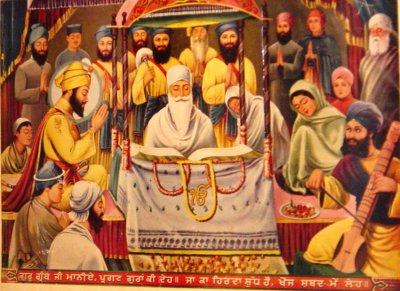The Guru Granth Saheb
by Dr. Jyotsna Kamat
First Online: June 07, 2006
Page Last Updated: December 07, 2024
Sri Granth Saheb (a.k.a. Guru Grunth Sahib) is the holiest book of Sikhs (granth, meaning book, saheb meaning supreme). It is called "Guru" because Guru Gobind Singh (1660-1708 C.E.), the tenth and last guru of the Sikhs, declared that after him, there will be no Guru and diktat of Granth Saheb will be final. Compiled by the fifth guru after Guru Nanak, Arjan Dev (1563-1606), Granth Saheb in a sense could be the holy book for Indian subcontinent as well. This is because besides compositions of Sikh gurus, it includes teachings and hymns of more than a dozen of other saints from different communities and regions. Compositions of Hindu, Muslim and Dalit (or depressed classes) from all over India are included in the book: Bhikan came from Oudh, Dhanna and Pipa from Rajasthan, Jaidev from Bengal, Ramanand, Kabir, Farid and Ravidas from Banaras (Varanasi, present day Uttar Pradesh), Namdev and Trilochan from Maharashtra. There were several devotees and disciples from Punjab whose hymns are also included.
Guru Nanak used to compose songs on the spot and sing. His disciples collected them in book form which was known as "Adigranth". Sayings (Shabad) and hymns of four gurus who followed him, Angad Amardas and Ramadas were also included in different books called "Pothis". Guru Arjan Dev took upon himself the tremendous task of compiling all the scattered songs, sayings and hymns (shabad and bani) sifting and marshalling. He even managed to get the manuscript "Pransangli" said to have been composed and sung by Guru Nanak, during his sojourn in Ceylon (Sri Lanka). This Guru, Arjun Dev himself provided much needed prayers, hymns and songs for group singing (bhajans). They form bulk of the book.
Guru Arjan Dev was a gifted poet and musician. All the spiritual literature has been classified in different ragas. Each song is indicated by a specific raga. Thirty one ragas prevalent then have been used. Arjan Dev got approval of the rendering of ragas and singing style from the bards who were traditional singers and who roamed the country.
The great Book was ready by 1604 C. E. Called Granth Saheb, it was installed at the Harimandir of Amristar. Guru Arjan Dev also built the Golden Temple.
The final compilation was done by Guru Gobind Singh in 1705 C. E. to include his father Guru Teg Bahadur's Slokas and only one `bani' of his own.
The holy book contains the following:
- Japji, prayer of meditation, composed by Nanak which is recited by every devout Sikh early in the morning.
- Sukhmani, Arjan Dev's composition and most popular one is recited before commencing daily chores.
- Rahiras are hymns of all the Gurus, sung in the evening, and at times, in congregation.
- Sohilas or Sohan-Velas are recited before going to bed.
© K. L. Kamat

Guru Gobind Singh Honoring Adi Granth
Guru Gobind Singh declared that he was the last of the Sikh gurus
and hence forth all reverence be provided only to the sacred book
The holy book of Granth Saheb gets the ritualistic worship which a supreme deity gets in Indian tradition. The custodian of the holy book is called Granthi. The learned person who interprets the hymns is called Gyani (as in Gyani Zail Singh, a former president of India)
The language of most compositions is old Punjabi while that of saints of other regions is Hindvi, Sadh Hindvi or old Hindi, prevalent among bards, pilgrims and fakirs who traveled throughout the country in those days. It was easily understood in most parts of North India. The script is Gurmukhi, which was invented by the second Guru Angad.
Granth Saheb is hailed for its spiritual message of the Omniscient and Omnipotent God's grace and for its poetry and as a guide to pious and chaste living and towards realization of God.
Famous places where a copy of Granth Saheb is installed and worshipped, are known as Gurdwaras. People of all creed and caste are welcome to offer prayers and partake prashad in langar (community dinner) at these places.
![]()
See Also:
- By Jyotsna Kamat -- Dr. Jyotsna Kamat is an active contributor to Kamat's Potpourri. Read all her articles here.
